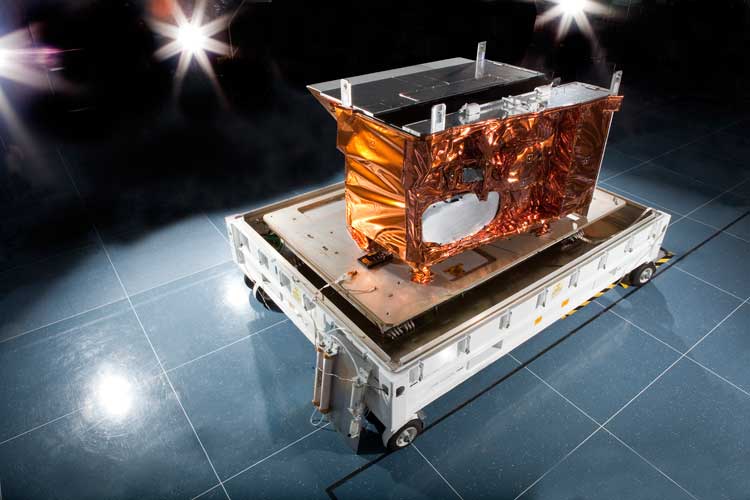 NASA's Black Marble
NASA's Black Marble
At night, satellite images of Earth capture a uniquely human signal--artificial lighting. Remotely-sensed lights at night provide a new data source for improving our understanding of interactions between human systems and the environment. NASA has developed the Black Marble, a daily calibrated, corrected, and validated product suite, so nightlight data can be used effectively for scientific observations. Black Marble is playing a vital role in research on light pollution, illegal fishing, fires, disaster impacts and recovery, and human settlements and associated energy infrastructures.

Black Marble’s standard science processing removes cloud-contaminated pixels and corrects for atmospheric, terrain, vegetation, snow, lunar, and stray light effects on the VIIRS Day/Night Band (DNB) radiances. The products are calibrated across time, validated against ground measurements, and include quality indicators so that they can be used effectively in science and applications studies. A detailed description of key algorithm enhancements can be found here
NASA’s Black Marble enables a wide range of applications for a broad spectrum of data users. Along with their primary purpose of supporting the short-term weather prediction and disaster response communities, they also provide new data for tracking wildfires, gas flares, and light pollution, and have numerous socioeconomic uses, such as proxying economic activity, monitoring changes in energy infrastructure in urban areas, and providing data to humanitarian organizations in conflict areas. A number of sources contribute to the nighttime environment, including city lights, lightning, fishing fleet navigation lights, gas flares, lava flows, and even auroras. When partial to full illumination from the moon is available, reflection of this lunar illumination off of ice, snow, and other highly reflective surfaces enable the study of ocean and terrestrial features.
The Visible Infrared Imaging Radiometer Suite (VIIRS) instrument is a component of the Suomi National Polar-orbiting Partnership (NPP) satellite. VIIRS consists of 22 spectral bands from the ultra-violet to the mid-infrared, one of which is able to observe nighttime lights, the day night band (DNB). DNB is a panchromatic band sensitive to visible and near-infrared wavelengths. Detailed design specs for VIIRS instrument can be found here.

Black Marble Product Availability
| Product ID | Distribution Service | Geographic Coverage | Temporal Coverage | Spatial Resolution | Temporal Resolution | Availability | Production Status | Product Availability |
|---|---|---|---|---|---|---|---|---|
| VNP46A1 | Free/Open Access | Global | 2012-YTD | 15 arc second | Daily | < 1day | In operations (2012-YTD) | Now - NASA LAADS Archive and Google EarthEngine |
| VNP46A2 | Free/Open Access | Global | 2012-YTD | 15 arc second | Daily | < 1day | In operation (2012-YTD) | Now - NASA LAADS Archive and Google EarthEngine |
| VNP46A3 | Free/Open Access | Global | 2012-YTD | 15 arc second | Monthly | 1 week | In operation (2012-YTD) | Now - NASA LAADS Archive |
| VNP46A4 | Free/Open Access | Global | 2012-YTD | 15 arc second | Annual | 1 week | In operation (2012-YTD) | Now - NASA LAADS Archive |
| Black Marble HD | Processing On-Demand* | Local-to-Regional | 2012-YTD | ≤ 30 m | Daily/Monthly/Annual | < 1 week | Processing On-Demand* | Processing On-Demand* |
| Black Marble NRT | Free/Open Access | Global | 2012-YTD | 15 arc second | Daily | < 1day | In operation (2012-YTD) | Lance - Daily AND Hourly Gridded |
*Currently only limited to collaborators on funded projects. Tools to produce the HD products will be available through Google Earth Engine.
Black Marble Daily Level 3 Products include the daily at-sensor top of atmosphere (TOA) nighttime radiance product (VNP46A1), and the daily moonlight-adjusted nighttime lights (NTL) product (VNP46A2)
Black Start 2019: Mapping Puerto Rico’s Recovery Through Satellite Data
2018 AGU Fall Meeting Press Conference: Puerto Rico one year later
Geo4Dev Symposium: The Role of #NASAEarthData in Strengthening Community Resilience
NASA / Texas Instruments Virtual Field Trip: Earth at Night
Library of Congress Seminar: Holiday Lights Show from Space
Facebook Live: A Look Inside The Most Power Storms of 2017
#ScienceinSeconds with Dr. Thomas Zurbuchen
2014 AGU Fall Meeting Press Conference: NASA Sees Holiday Lights from Space
"Conflict in Syria" BBC. November, 2024
"Dark Nights in Georgia" NASA Earth Observatory. October, 2024
"Derecho Darkens Houston" NASA Earth Observatory. May 23, 2024
"Tracking Nightlights in Libya" NASA Earth Observatory. September 25, 2023
M. O. Román, Eleanor C. Stokes, Ranjay Shrestha, Zhuosen Wang, Lori Schultz, Edil A. Sepúlveda Carlo, Qingsong Sun, Jordan Bell, Andrew Molthan, Virginia Kalb, Chuanyi Ji, Karen C. Seto, Shanna N. McClain, and Markus Enenkel. 2019. "Satellite-based assessment of electricity restoration efforts in Puerto Rico after Hurricane Maria." PLoS ONE 14 (6) [ doi:10.1371/journal.pone.0218883]
Wang, Z., Shrestha, R.M., Román, M.O. and Kalb, V.L. 2022. "NASA’s Black Marble Multi-Angle Nighttime Lights Temporal Composites." IEEE Geoscience and Remote Sensing Letters.[ doi:10.1109/LGRS.2022.3176616]
Wang, Z., M. O. Román, V. L. Kalb, S. D. Miller, J. Zhang, and R. M. Shrestha. "Quantifying uncertainties in nighttime light retrievals from Suomi-NPP and NOAA-20 VIIRS Day/Night Band data." Remote Sensing of Environment 263 (2021): 112557 [ 10.1016/j.rse.2021.112557]
Wang, Z., M. O. Román, Q. Sun, A. L. Molthan, L. A. Schultz, and V. L. Kalb. 2018. "Monitoring Disaster-Related Power Outages Using NASA Black Marble Nighttime Light Product." ISPRS - International Archives of the Photogrammetry, Remote Sensing and Spatial Information Sciences XLII-3 1853-1856 [ doi:10.5194/isprs-archives-xlii-3-1853-2018]
Román, M. O., Z. Wang, Q. Sun, V. Kalb, S. D. Miller, A. Molthan, L. Schultz, J. Bell, E. C. Stokes, B. Pandey, K. C. Seto, D. Hall, T. Oda, R. E. Wolfe, G. Lin, N. Golpayegani, S. Devadiga, C. Davidson, S. Sarkar, C. Praderas, J. Schmaltz, R. Boller, J. Stevens, O. M. Ramos Gonzalez, E. Padilla, J. Alonso, Y. Detrés, R. Armstrong, I. Miranda, Y. Conte, N. Marrero, K. MacManus, T. Esch, and E. J. Masuoka. 2018. "NASA’s Black Marble nighttime lights product suite." Remote Sensing of Environment 210 113-143 [ doi:10.1016/j.rse.2018.03.017]
Enenkel, M., Ranjay Shrestha, Eleanor C. Stokes, M. O. Román, Zhuosen Wang, T. M. Espinosa, Ivana Hajzmanova, Justin Ginnetti, Patrick Vinck. 2019. "Emergencies do not stop at night: Advanced analysis of displacement based on satellite-derived nighttime light observations." IBM Journal of Research and Development [ doi:10.1147/JRD.2019.2954404]
Noam Levin, Christopher C. M. Kyba, Qingling Zhang, Alejandro Sánchez de Miguel, Miguel O. Román, Xi Li, Boris A. Portnov, Andrew L. Molthan, Andreas Jechow, Steven D. Miller, Zhuosen Wang, Ranjay M. Shrestha, Christopher D. Elvidge. 2020. "Remote sensing of night lights: A review and an outlook for the future." Remote Sensing of Environment. Volume 237 [ doi:10.1016/j.rse.2019.111443]
Cole, T., D. Wanik, A. Molthan, M. Román, and R. Griffin. 2017. "Synergistic Use of Nighttime Satellite Data, Electric Utility Infrastructure, and Ambient Population to Improve Power Outage Detections in Urban Areas." Remote Sensing 9 (3): 286 [ doi:10.3390/rs9030286]
Román, M. O., and E. C. Stokes. 2015. "Holidays in lights: Tracking cultural patterns in demand for energy services." Earth’s Future 3 (6): 182-205 [ doi:10.1002/2014ef000285]
PRINCIPAL INVESTIGATORS
Zhuosen Wang, UMD/NASA GSFC
SCIENCE TEAM
Virginia Kalb, NASA GSFC
Miguel Román, NASA GSFC
Ranjay Shrestha, SSAI/NASA GSFC
Srija Chakraborty, USRA/NASA GSFC
Zhe Zhu, UCONN
DISASTER COORDINATOR
Rachel (Soobitsky) Vershel, SSAI/NASA GSFC
LANCE NRT COORDINATOR
Tian Yao, SSAI/NASA GSFC